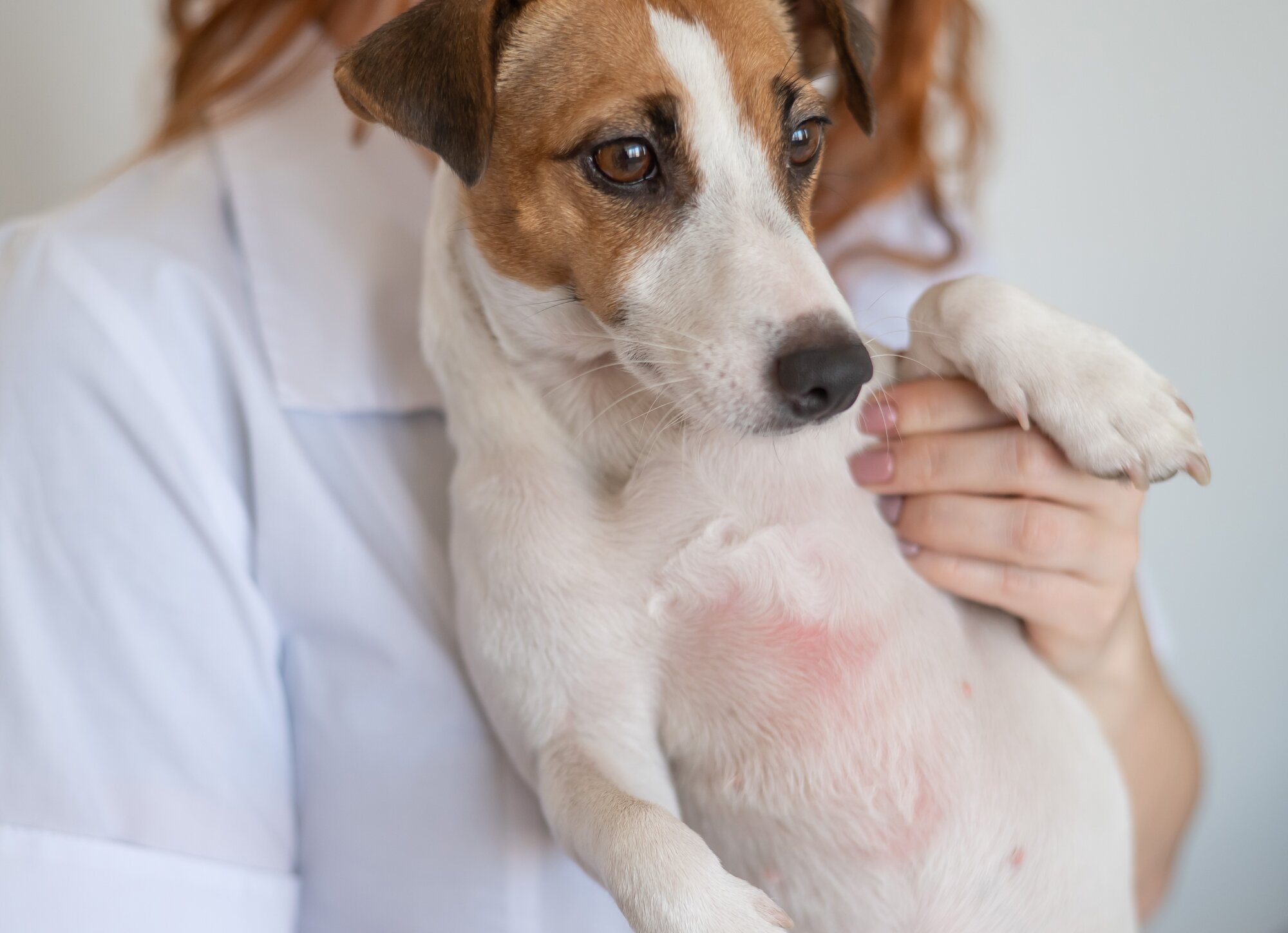Most dogs are known for their soft, fur coats. But did you know — under their coat of beautiful hair — your dog can also suffer from flaky, dry skin?
Treating dry skin looks different for each dog, depending on the cause of the skin condition. Knowing the difference helps you understand best how to treat dry skin on dogs.
In this article, we'll cover:
- Why do dogs get dry skin
- Signs of dry, itchy skin
- How to treat your dog's dry skin

Why do dogs get dry skin
Itchy or dry skin on dogs is fairly common. But what causes it? Here are some common triggers that may cause dry skin on dogs.
Parasites
Pests and bugs like fleas, ticks, mosquitoes, mites, and lice burrow in your dog's coat and bite their skin. Fleas are a serious threat to your dog's skin and coat health.
Flea bites and other parasites lead to skin issues like:
- Severe itching
- Irritated skin
- Allergic reaction
- Walking dandruff
- Skin infections
- Flea allergy dermatitis
Allergies
Dogs get allergies like humans do. Environmental allergens in your home and outdoors may cause allergies in your dog.
Some common environmental allergies in dogs are caused by triggers like:
- Animal dander
- Pollens
- Flea saliva
- Dust mites
Dogs may also have dry, flaking skin from food allergies. Visit a doctor of veterinary medicine for an allergy test to find out what triggers your dog is sensitive to.
Genetics
Some dog breeds are more prone to skin conditions than others. Hairless breeds are especially prone to sunburns, which can lead to flaky skin in mild cases.
Other breeds prone to skin conditions include:
- American Bulldogs
- Chinese Shar-Peis
- Doberman Pinschers
- English Bulldogs
- Labrador Retrievers
- Pit Bull Terriers
- Spaniels
- Standard Poodles
- West Highland Terriers
Signs of dry, itchy skin
Dry skin looks different for every dog. The most common signs of dry skin on dogs include:
- Itching and scratching
- Licking their paws
- Dandruff
- Skin flaking
- Inflammation and swelling
- Scabs
- Hot spots
- Odor
- Hair loss
- Secondary skin infections
- Fungal infections

How to treat dry skin on dogs
Dry skin treatment varies from case to case. The best remedies for your dog's dry skin depends on the cause.
Once you figure out the root cause of your dog's skin problems, try one of these 8 ways to treat your dog's dry skin.
1. Feed your dog a balanced diet.

Your dog's diet plays a large role in their overall health. Nutritional deficiencies and food allergies can lead to flaky, dry dog skin and hair loss.
Unsweetened yogurt is a healthy meal topper with vitamins and minerals to help your dog feel less itchy. Add a tablespoon to your dog's meals a few times a week to promote a healthy coat and skin.
2. Use flea and tick prevention.

Most flea and tick prevention kill and prevent fleas, ticks, and dog and cat lice. Stop your dog's symptoms at the source with a regular flea and tick treatment for your dog.
3. Treat your dog's allergies.

If you are new to the dog allergy world, you may be wondering what you can give your dog for allergies. There are plenty of over-the-counter antihistamine options for your dog, like:
- Benadryl
- Zyrtec
- Claritin
- Allegra
READ THE LABEL CAREFULLY BEFORE GIVING YOUR DOG ANTIHISTAMINES.
Be sure that the product only contains antihistamines. Talk with your vet before giving your dog allergy medication — each is dosed according to your dog's body weight.
4. Try a humidifier.

Like its effects on humans, dry air can lead to dry skin in dogs. If you notice your dog's skin is especially dry during the winter months, a humidifier may be beneficial.
Place a humidifier in your home or where your dog spends most of their time. As your dog's skin adjusts to the moisture, it may heal without needing additional treatment.
5. Give your dog an oatmeal bath.

Oatmeal has calming properties that help treat irritated, dry skin on dogs. Plus, it's a food item that most dog owners have on hand at home.
To make your own oatmeal bath:
- Pour roughly 1 cup of plain, unflavored oatmeal in a blender or food processor.
- Blend until the oats turn into a fine powder.
- Dump the powder into a warm bath while the water is running.
- Place your dog in the tub and use a cup to pour the oatmeal bath water all over their body.
- Rinse your dog with clean water and dry them off with a soft towel.
6. Let your dog's skin soak in epsom salt.

Older dogs may benefit from a warm soak in epsom salt if they have itchy, flaky skin. Epsom salt has healing and soothing properties that can bring instant relief to your dog's dry skin.
To give your dog an epsom salt soak:
- Identify the dry skin area that needs attention.
- Add one cup of epsom salt into one gallon of warm water in a plastic tub.
- If your dog's paws are irritated, place them in the tub and let your dog soak for a few minutes.
- If the irritated area does not fit in the plastic tub, slowly pour the water mixture over the affected area.
- After you are finished soaking the area for a few minutes, rinse with clean water. Avoid letting your dog lick or drink the bath water.
7. Maintain proper grooming.

Proper grooming is important to maintain a healthy coat and prevent dry skin. Always use pet-safe products when bathing your pet.
Degreasing soap and shampoos strip the natural oils from your dog's skin. To restore the skin's protective barrier, use a pet-safe, moisturizing shampoo.
VET TIP
Avoid excessive bathing to prevent dry skin in dogs. Most dogs only need baths a few times a year on an as-needed basis.
8. Experiment with natural remedies.

At-home remedies can be beneficial to soothe dry skin on dogs. Always consult your vet before adding these remedies for dry skin into your dog's health regimen.
Here are some home remedies that may help soothe dry skin in dogs:
Aloe vera
Aloe vera's healing properties and fatty acids are great for skin infections, cuts, and dry skin on dogs. Pet parents can apply it directly to their dog's skin to soothe itching and pain.
Disclaimer: Aloe vera is toxic if ingested, but not if applied on the skin.
Oils
Applying oils to your dog's dry skin or adding it to their diet may help their condition.
- Salmon oil and fish oil: Fish oil and salmon oil reduce itchy and flaky skin. Plus, they can also relieve allergies and joint pain.
- Olive oil: Olive oil contains omega-3 fatty acids that benefit your dog's skin and coat. To use olive oil for dry skin, add one tablespoon of olive oil to your dog's food a few times a week.
- Vitamin E oil: Adding vitamin E oil to your dog's meals is a simple way to boost their skin quality. There are also dog food options that have a boost of vitamin E for preventing dry skin.
- Coconut oil: Coconut oil is a great natural moisturizer. Plus, it's antibacterial. To use coconut oil for dry skin, chill it in the refrigerator and massage a small amount into problem areas on your dog's skin.
Apple cider vinegar
Yeast infections can cause itchy, dry skin on dogs. To treat it, make a 50/50 solution with water and apple cider vinegar. Apply the mixture on your dog's dry skin with a cotton ball or spray bottle. Avoid applying on areas with open wounds, as the vinegar will make them sting.
Green tea
Green tea has anti-inflammatory properties that soothe skin infections and itchy skin on dogs. Pet parents can soak green tea bags in a tub of warm water to treat their dog's dry skin. Similar to an oatmeal bath, let your dog stand in the water mixture and use a cup to pour it over their skin.

Dry skin is an issue that affects some dogs. Knowing what causes dry skin on dogs and how to treat it will put you in the best position to keep your dog's skin and coat in tip-top shape.

